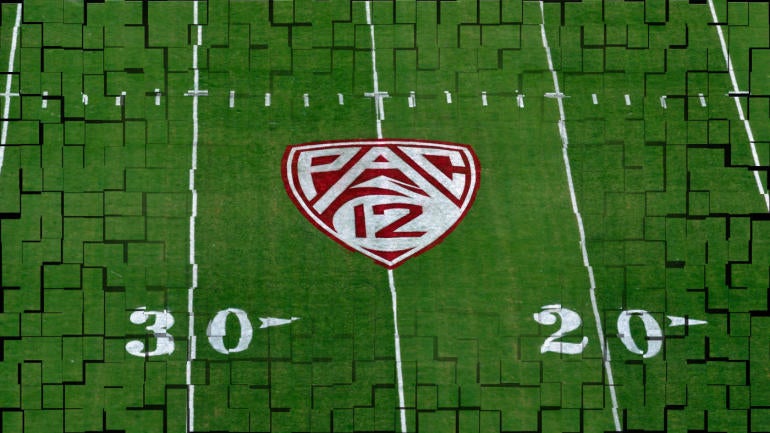
A college landscape without the Pac-12 has become a storyline worth considering, though a break-up of the 107-year-old league isn't particularly likely.
Industry sources still project a media rights deal split between ESPN and Amazon for the embattled conference. However, dissolution of the Pac-12 is being talked about openly in those same industry circles as a potential consequence if the league does not wrap up its new deal soon.
The fact that it could happen in these tenuous times is enough to project what the process might look like.
Multiple sources tell CBS Sports the league is struggling to match its desired value for its 10-team league (south of $400 million annually, $40 million per school) following the departures of USC and UCLA to the Big Ten.
The most compelling reason: As it stands, the Pac-12 inventory of games is not something broadcast, linear cable or streaming must have at this point.
Not without USC and UCLA. Not with the league is in its eighth month since losing its two flagships. And not with 3.5 months having passed after the Pac-12 was leapfrogged by the Big 12.
The Big Ten is now coast-to-coast, spread across the three major broadcast networks (CBS, Fox, NBC). ESPN has gone all in on the SEC with an exclusive deal including the lucrative 3:30 p.m. ET window on Saturdays as well as the primetime slot with some of the highest-rated inventory in the sport. The ACC is locked in through 2036 at a stable number that is expected to grow as the ACC Network continues to throw off revenue. The Big 12 has staked its claim with Fox and ESPN, and it is looking to get bigger with expansion.
There is a finite amount any potential rightsholder is willing to pay for a damaged conference that is the last among the Power Five to complete a new media rights deal. Perhaps that was the implicit intent of the conference's recent statement from its presidents -- to calm fears.
Now consider what has impacted the Pac-12 and some of its potential bidders just since the beginning of the year:
- The league discovered it may owe a media partner $50 million.
- Disney (parent company of ESPN) announced it is laying off 7,000 employees in a restructuring.
- Amazon recently laid off 6% of its work force (18,000 globally).
- Alphabet (parent company of Google) cut 12,000 jobs.
The Pac-12 may have simply waited to too long to do a deal that makes financial sense to some of its members. CBS Sports previously reported the Pac-12 may have to commit to expansion in order to maximize the value of a deal.
The bulk of the other Power Five's games are on what are still-reliable linear platforms (broadcast, cable). Linear continues to outperform streaming by a large margin. Consider, during the 2022 season, the SEC and Big Ten had a combined 50 conference games that finished in the top seven of the weekly TV ratings.
The Pac-12 had one such game that didn't include USC or UCLA, according to SportsMediaWatch.com
When the Big 12 similarly lost its two flagships programs, the league acted decisively to expand under then-commissioner Bob Bowlsby. Under new commissioner Brett Yormark, the Big 12 jumped ahead of the Pac-12 with that new media rights deal.
The Pac-12 has reached a point where the best broadcast windows on the best networks are filled with premium content from other conferences while streaming remains an unproven home. Did the league simply overvalue itself?
Taking all that into account, here is a step-by-step look at what would happen if the Pac-12 disbanded.
Why would the Pac-12 break up?
Basically, the current members would get nervous enough over a lack of value coming back to them in a media rights deal in conjunction with dissipating exposure and perceived prominence for their universities and athletic programs.
How will Pac-12 games be seen by a broad audience if they are not on TV or the best windows, which are filling up fast. If significantly more than half of future Pac-12 games project to be on a streaming serve, as CBS Sports previously reported, that's a bad sign. Again, linear is still the preferred delivery system for live sports.
On a streaming carrier, the Pac-12 would lose significant visibility That translates -- for starters -- to declined recruiting and a struggle to hire top coaches if their games will not be widely available.
If individual or collective Pac-12 schools sense they can make more money and receive better exposure in another Power Five conference, they have no choice but to look out for the long-term financial security of their universities and athletic departments. Football (and basketball) media rights basically fund a program's remaining sports.
Where would Pac-12 teams go?
If the Pac-12 ultimately breaks up, most -- but not all -- of its membership would find waiting Power Five homes. It would kick off another round of expansion and may result in further changes coming down the road.
Four Corners schools
Arizona, Arizona State, Colorado and Utah have been Big 12 targets, in some form, since USC and UCLA announced plans last summer to leave fo the Big Ten.
That interest has picked up considerably with the Pac-12 appearing even more vulnerable. Yormark wants to have membership in the Pacific Time Zone. That would make the Big 12 the only conference to have members across all four time zones.
Adding the Four Corners schools would also make the Big 12 the third conference with 16 members joining the SEC and Big Ten.
- Arizona would enhance the Big 12's basketball reputation. (Gonzaga is in consideration as a basketball-only member.)
- Arizona State is one of the biggest sleeping giants in the country playing in the nation's 11th biggest market (just outside Phoenix).
- Colorado is a former Big 12 member, achieving its greatest success in the league in the old Big Eight. Deion Sanders at CU is a walking, talking marketing executive. Whatever he accomplishes, it can't hurt viewership.
- Utah (along with Oregon) is arguably the Pac-12's strongest remaining football program. It would also give BYU a travel partner.
In essence, adding those four schools would create more Big 12 content in more time slots. Such an expansion might reflect what the Pac-12 is worth right now. If the Big 12 expands, its contract states new team(s) would get 63% of pro rata revenue from ESPN (approximately $20 million annually). If that's what compels those schools to move, what does it say about the current worth of the Pac-12?
Oregon and Washington
Assuming the Four Corners bolt first, that creates a decision for what would become the two biggest available brands in the country. Keyword "available" because, with the league crumbling around it, Oregon and Washington would have options. And their best option would likely be the Big Ten.
The schools align academically with the Big Ten. They would join USC and UCLA, mitigating travel issues in the Big Ten for all four schools with more games closer to home.
Even if the Pac-12 stays together, how long until Oregon and Washington have wandering eyes? Nike founder and Oregon benefactor Phil Knight has been looking out for the Ducks since early in the process. CBS Sports confirmed Washington's interest in the Big Ten last fall, which was termed significant at the time, if the Pac-12 didn't work out.
It is known outgoing Big Ten commissioner Kevin Warren wanted further conference expansion seeking to add those two schools as well as Stanford and California. There was much pushback from Big Ten presidents and athletic directors, but with the Pac-12 potentially decided its own fate, the Big Ten wouldn't be perceived as breaking up the league this time around, avoiding a possible costly legal challenge. (This time, however, the Big Ten would likely want no part of Stanford and Cal.)
An 18-team league would make the Big Ten the biggest in the history of major-college football. It would create significant scheduling issues and result in balking from existing rightsholders, who will be asked to pay more. Perhaps a streaming service would get involved to defer costs.
Best guess: Oregon and Washington would take less than a full Big Ten share (estimated $75 million per school starting in 2024) at least initially to be part of the richest conference in the land.
The last four
Out of that upheaval emerges a conference of leftovers. Think of a Pac-12 -- or whatever it is called by then -- attempting to forge ahead with its four remaining schools (Cal, Oregon State, Stanford, Washington State) while filling the rest of the conference with Mountain West programs. (It could also go the other direction.)
San Diego State and SMU are already projected as expansion candidates if the Pac-12 survives, so pencil them in to make it six teams in the hybrid league. A corner bar discussion might reveal a new Pac-12 that looks like this:
- Cal
- Boise State
- Fresno State
- Oregon State
- San Diego State
- SMU
- Stanford
- Washington State
That lineup would reduce the Power Five to the Power Four, creating implications beyond the Pac-12 itself.
Pac-12's best chance
The way out of this muck is a 12-team league that includes San Diego State and SMU appearing to present more value to potential rightsholders.
The Pac-12 has been positioning itself for such an expansion while struggling to meet its goals. SDSU gives the Pac-12 a presence once again in Southern California. SMU gives the league some things it never possessed: games in the noon ET window and a recruiting foothold in Texas. We've detailed San Diego State's advantages.
Adding the two teams would give rightsholders 90 Pac-12 games on which to bid. But again, that's assuming there's enough bidders with enough money left for the remains of the Conference of Champions.





















